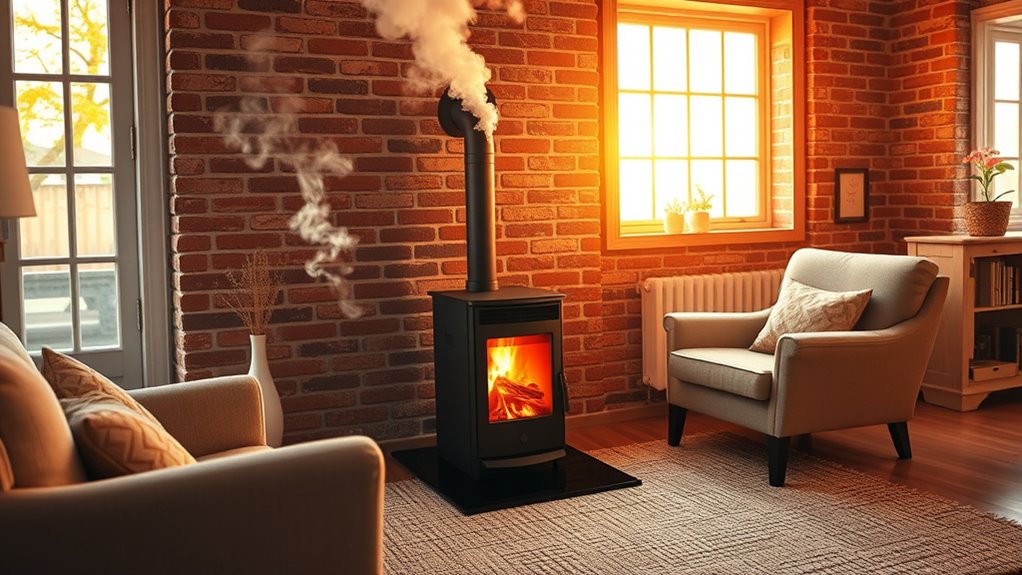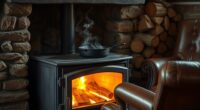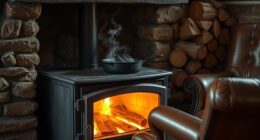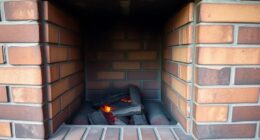To strategically use zone heating with pellet stoves, focus on high-traffic or comfort-priority areas like living rooms and bedrooms. Properly select stoves with the right BTU ratings for each space and position them to maximize airflow and efficiency. Incorporate thermostats and barriers to control heat and prevent energy waste. With careful planning and placement, you’ll enjoy targeted warmth and save on energy costs—continue exploring to discover how to optimize your system even further.
Key Takeaways
- Identify high-traffic or comfort-priority zones to install pellet stoves for targeted heating.
- Match stove capacity and heat output to each room’s size and insulation qualities.
- Place stoves strategically for optimal airflow, avoiding obstructions and ensuring efficient heat distribution.
- Incorporate zone thermostats and smart controls for precise temperature management and energy efficiency.
- Use barriers, insulation, and ventilation techniques to contain heat within designated zones effectively.
Understanding the Benefits of Zone Heating With Pellet Stoves
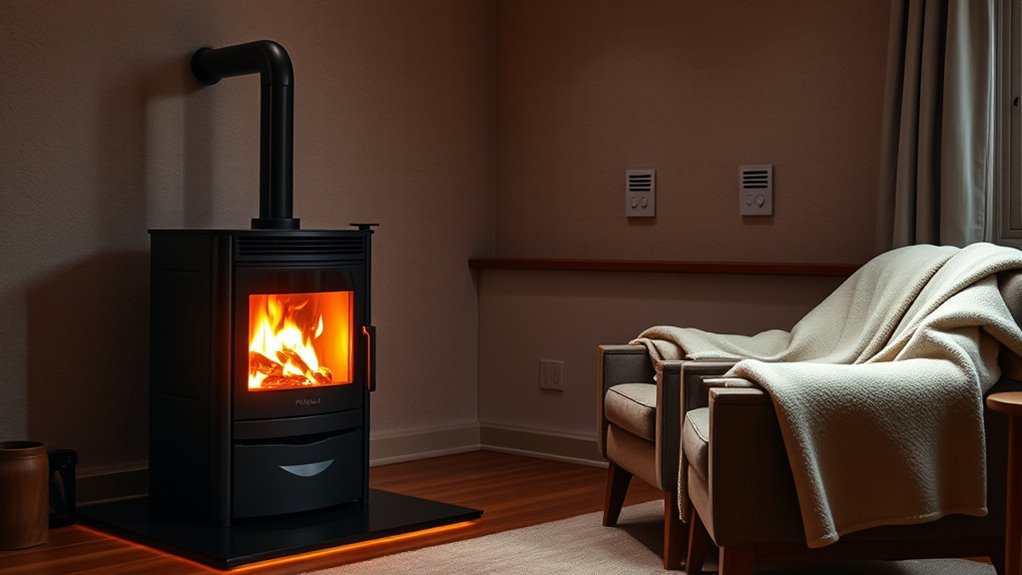
Zone heating with pellet stoves offers several compelling benefits, especially when you want to optimize comfort and efficiency. By focusing heat on specific areas, you reduce energy waste and lower your heating costs. Pellet stoves are easy to control, allowing you to adjust temperatures in different zones based on your needs. This targeted approach keeps your living spaces warmer without overheating the entire home, leading to increased comfort. Additionally, pellet stoves use renewable fuel sources, making them an environmentally friendly choice. They operate efficiently and require less maintenance than traditional heating systems. The high efficiency of pellet stoves means you get more warmth with less fuel consumption, further enhancing their appeal. Modern pellet stoves also incorporate smart technology, allowing for better remote control and scheduling options. Thanks to zone heating, you can customize your home’s warmth to match your lifestyle and occupancy patterns. Implementing advanced controls can further optimize energy use and comfort. In addition, the integration of quieter operation features ensures a peaceful environment while heating your home. Overall, zone heating with pellet stoves gives you greater control over your home’s comfort and helps you save money while reducing your environmental impact.
Planning Effective Zones in Your Home
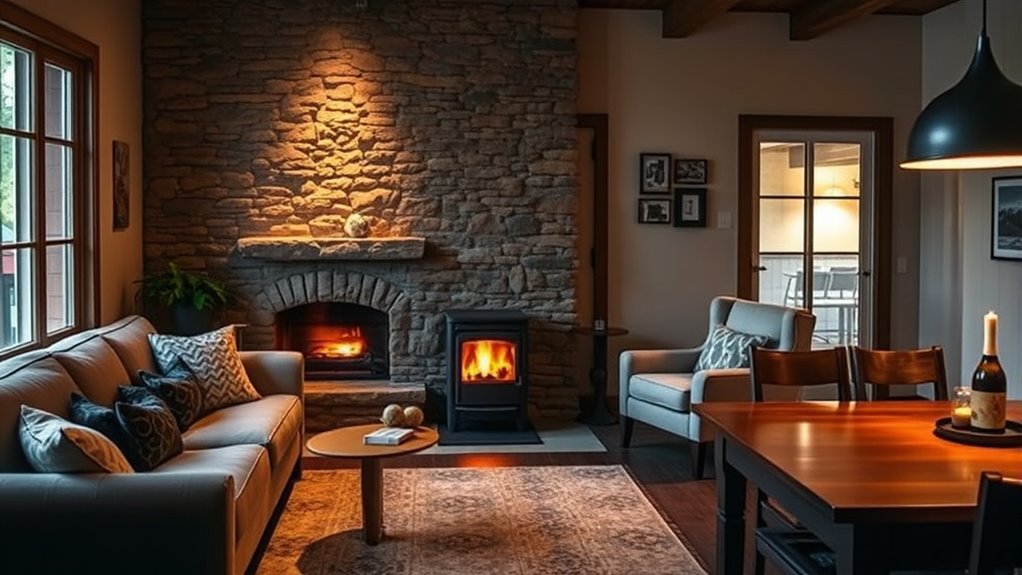
To maximize the benefits of pellet stove zone heating, it’s important to plan your home’s layout thoughtfully. Start by identifying the areas where you spend the most time or want the most warmth, such as living rooms or bedrooms. Consider how heat will circulate between zones and avoid obstructing airflow with furniture or closure of vents. Group rooms with similar heating needs together to ensure consistent comfort. Use doorways, curtains, or temporary barriers to contain heat within specific zones when needed. Map out a clear plan for distributing your pellet stove’s heat efficiently, keeping in mind the natural flow of air and the placement of thermostats. Proper planning guarantees each zone receives adequate warmth without wasting energy or creating hot spots. Additionally, understanding the importance of effective space utilization can help optimize your heating strategy and improve overall comfort. Paying attention to home layout and airflow can further enhance the efficiency of your zone heating system. Recognizing heat flow patterns within your home can assist in fine-tuning the zones for better temperature regulation. Incorporating proper insulation into your planning process can also help retain heat and reduce energy consumption. Moreover, considering ventilation can prevent humidity buildup and improve indoor air quality, contributing to a healthier living environment.
Selecting the Right Pellet Stove for Each Area

Choosing the right pellet stove depends on matching its size and heat output to each room’s needs. You should also consider how the stove’s design fits with your space’s style. Additionally, selecting high-quality essential oils for maintenance or aromatherapy can enhance your experience and prolong the stove’s lifespan essential oils. Regular maintenance with stove cleaning products can further ensure optimal performance and safety. Moreover, considering the retail hours for related supplies can help you plan timely visits for upgrades or replacements. Understanding self watering plant pots can also provide insights into efficient water management, which can be analogous to optimizing stove operation. Developing a comprehensive personal finance management plan can help you allocate resources effectively for equipment upgrades or repairs. By focusing on these factors, you’ll guarantee effective and attractive heating in every area.
Room Size Compatibility
Finding the right pellet stove for each room depends on understanding its size and heating needs. Measure the space accurately—length, width, and height—and consider insulation quality. Larger rooms require stoves with higher heat output, while smaller areas need less powerful models to avoid overheating. Check the stove’s heating capacity, often listed in BTUs or square footage coverage, to ensure it matches your room size. If your space is open-plan, select a stove that can efficiently distribute heat across the entire area. Remember, a stove that’s too small won’t warm the room effectively, and one that’s too large can lead to unnecessary energy use and temperature fluctuations. Matching your stove’s capacity to your room size guarantees comfort and efficiency. Additionally, consider the energy efficiency ratings of the pellet stove, as these can significantly impact long-term operating costs and performance.
Heat Output Options
Selecting the right pellet stove for each area depends on understanding its heat output options. You need to match the stove’s capacity to the space’s size and heating needs. A stove with too high a heat output can cause overheating, while one with too low may struggle to warm the room effectively. Incorporating sound vibrations into your selection process can also help you better understand how the stove’s operation may affect your home’s overall comfort and health. Consider these key factors: – BTU Rating: Indicates the stove’s heating power; choose based on the room size. – Adjustable Settings: Allows you to control heat levels for more precise zone heating. – Efficiency Ratings: Higher efficiency means better heat transfer and lower fuel consumption. Additionally, understanding Glycolic Acid benefits can inform how you maintain and improve your home’s heating systems for optimal performance.
Aesthetic and Design
Since the aesthetic and design of your pellet stove can considerably impact the overall look of your space, it’s important to take into account how well it integrates with your decor. Think about the style, color, and finish that match your interior. If your home has a modern vibe, opt for sleek, minimalist models with clean lines. For a rustic or traditional look, choose stoves with a stone or metal finish that complements your furnishings. You’ll also want to reflect on the size and shape to ensure it fits comfortably without overwhelming the room. Some stoves feature glass fronts for a cozy view of the flames, adding visual appeal. Selecting a pellet stove that aligns with your decor enhances both functionality and aesthetic harmony in your space.
Installing and Positioning for Optimal Efficiency
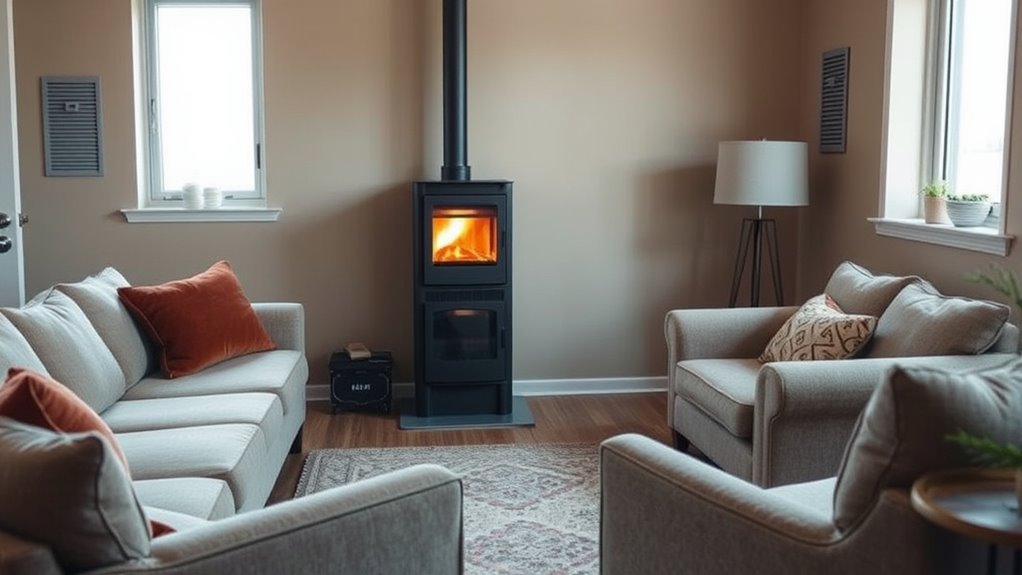
Proper installation and strategic positioning are essential to maximize the efficiency of your pellet stove. You want to place your stove where it can effectively heat your targeted zones without excessive energy loss. Consider factors like airflow, clearance, and proximity to vents. A well-positioned stove minimizes heat loss and ensures even distribution.
To optimize placement:
- Avoid tight corners or enclosed spaces that restrict airflow
- Maintain proper clearance from combustible materials
- Position the stove where it can easily connect to existing ventilation and exhaust systems
Managing and Controlling Multiple Heating Zones

Managing multiple heating zones becomes easier when you incorporate zone thermostats, giving you precise control over each area. Balancing heat distribution guarantees every space stays comfortable without wasting energy. With the right setup, you can optimize your pellet stove system for maximum efficiency and comfort.
Zone Thermostat Integration
Integrating zone thermostats with pellet stoves allows you to precisely control multiple heating areas, guaranteeing comfort and efficiency throughout your space. By connecting thermostats to each zone, you can set specific temperatures, reducing energy waste and maintaining consistent warmth where needed. This setup enables you to respond quickly to changing comfort levels, avoiding overheating or underheating rooms. Proper integration involves selecting compatible thermostats, wiring them correctly, and configuring your system for peak performance. It’s essential to ensure each thermostat accurately measures the zone’s temperature and communicates effectively with your pellet stove system. When done correctly, this integration offers a sophisticated way to customize your heating, save energy, and improve overall comfort.
- Compatibility considerations for thermostats and pellet stoves
- Wiring and configuration best practices
- Ensuring accurate temperature sensing in each zone
Balancing Heat Distribution
Balancing heat distribution across multiple zones guarantees that each area receives appropriate warmth without wasting energy. To achieve this, you should regularly monitor your thermostats and adjust dampers or vents to direct airflow where needed. It’s important to identify zones that are too hot or too cold and tweak their settings accordingly. Using smart thermostats can help automate this process, ensuring consistent comfort while optimizing efficiency. Avoid overloading any single zone, as this can cause uneven heating and strain your system. Keep ductwork clear of obstructions and insulate properly to prevent heat loss. By actively managing each zone and making small adjustments over time, you ensure your pellet stove system operates smoothly, delivering balanced heat and conserving energy.
Tips for Maximizing Comfort and Saving Energy
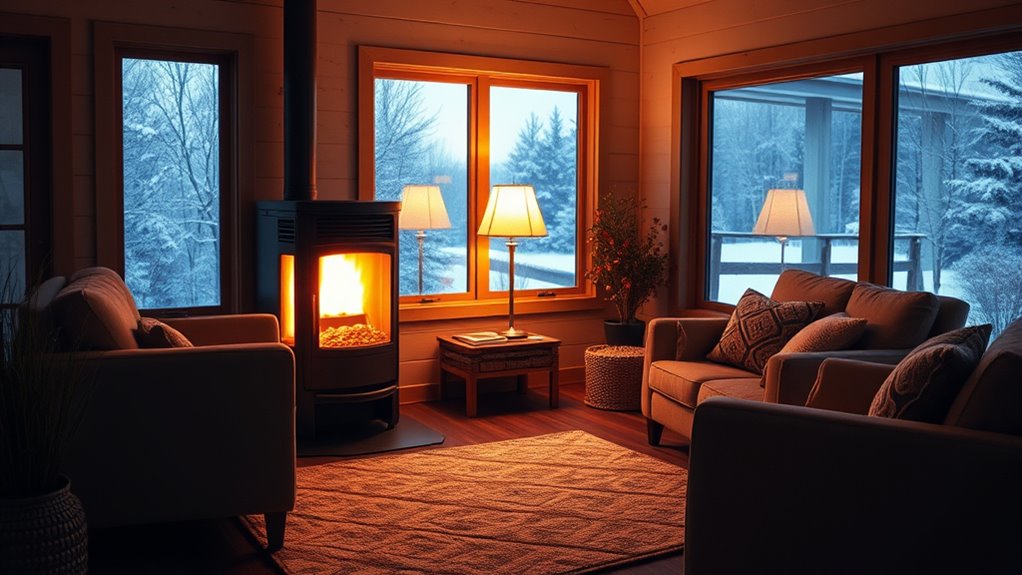
To maximize both comfort and energy savings with your pellet stove, focus on strategic placement and proper operation. Position your stove in a central location to promote even heat distribution and avoid obstructions that block airflow. Regularly clean and maintain your stove to keep it running efficiently, preventing unnecessary energy waste. Use a programmable thermostat to control when the stove operates, avoiding overheating and reducing costs. Additionally, consider installing fans or vents to direct warm air into colder areas.
- Optimize airflow with strategically placed fans or vents
- Schedule operation during peak times to avoid unnecessary use
- Insulate your home to retain heat and reduce energy consumption
Frequently Asked Questions
How Do Pellet Stoves Compare to Traditional Heating Systems in Cost?
When comparing pellet stoves to traditional heating systems, you’ll find pellet stoves often cost less to operate over time. They use affordable, renewable fuel and tend to be more energy-efficient, reducing your monthly bills. While the initial installation might be higher, your ongoing expenses decrease. Plus, pellet stoves provide consistent warmth and can be used to zone heat specific areas, saving you even more money in the long run.
Can Pellet Stoves Be Integrated With Existing Home Automation Systems?
Imagine your home as a symphony, with each note perfectly timed—pellet stoves can be the conductor, seamlessly integrating with your automation system. You can control your stove remotely, schedule heating schedules, and monitor performance from your smartphone. Many pellet stoves are compatible with smart home platforms like Google Home or Alexa, giving you the power to bring warmth and convenience together, creating harmony in your living space.
What Are the Safety Considerations for Multi-Zone Pellet Stove Setups?
When setting up multi-zone pellet stoves, you need to prioritize safety. Guarantee proper ventilation to prevent carbon monoxide buildup, and install smoke and carbon monoxide detectors in all zones. Use reliable thermostats and control systems to avoid overheating or malfunctions. Regular maintenance and inspections are essential. Keep flammable materials away from stoves and follow manufacturer guidelines. These steps help keep your multi-zone setup safe and efficient.
How Often Should Pellet Stoves and Their Components Be Maintained?
Ever wondered how often you should check your pellet stove? Regular maintenance is key to keeping it running smoothly and safely. You should clean the burn pot and remove ash weekly, check the glass for soot monthly, and schedule professional inspections annually. Don’t forget to inspect the venting system regularly. Staying on top of these tasks prevents breakdowns and guarantees efficient heating. Isn’t it worth a little effort for cozy, worry-free warmth?
Are There Any Health Concerns Associated With Pellet Stove Emissions?
You might wonder if pellet stove emissions pose health risks. While modern pellet stoves are designed to burn cleanly, they can produce some particulate matter and carbon monoxide if not properly maintained. It’s important to guarantee good ventilation, use high-quality pellets, and keep your stove well-maintained. Doing so minimizes any potential health concerns and keeps your indoor air safe, allowing you to enjoy warm, efficient heating comfortably.
Conclusion
By zoning your home with pellet stoves, you gain control, comfort, and efficiency. You can target heat where you need it, save energy, and reduce costs. You can enjoy cozy spaces, maintain consistent temperatures, and optimize your system’s performance. You can create a warm, inviting environment, enhance your home’s value, and simplify your heating routine. Embrace zoning with pellet stoves to make your home more comfortable, more efficient, and more tailored to your lifestyle.
